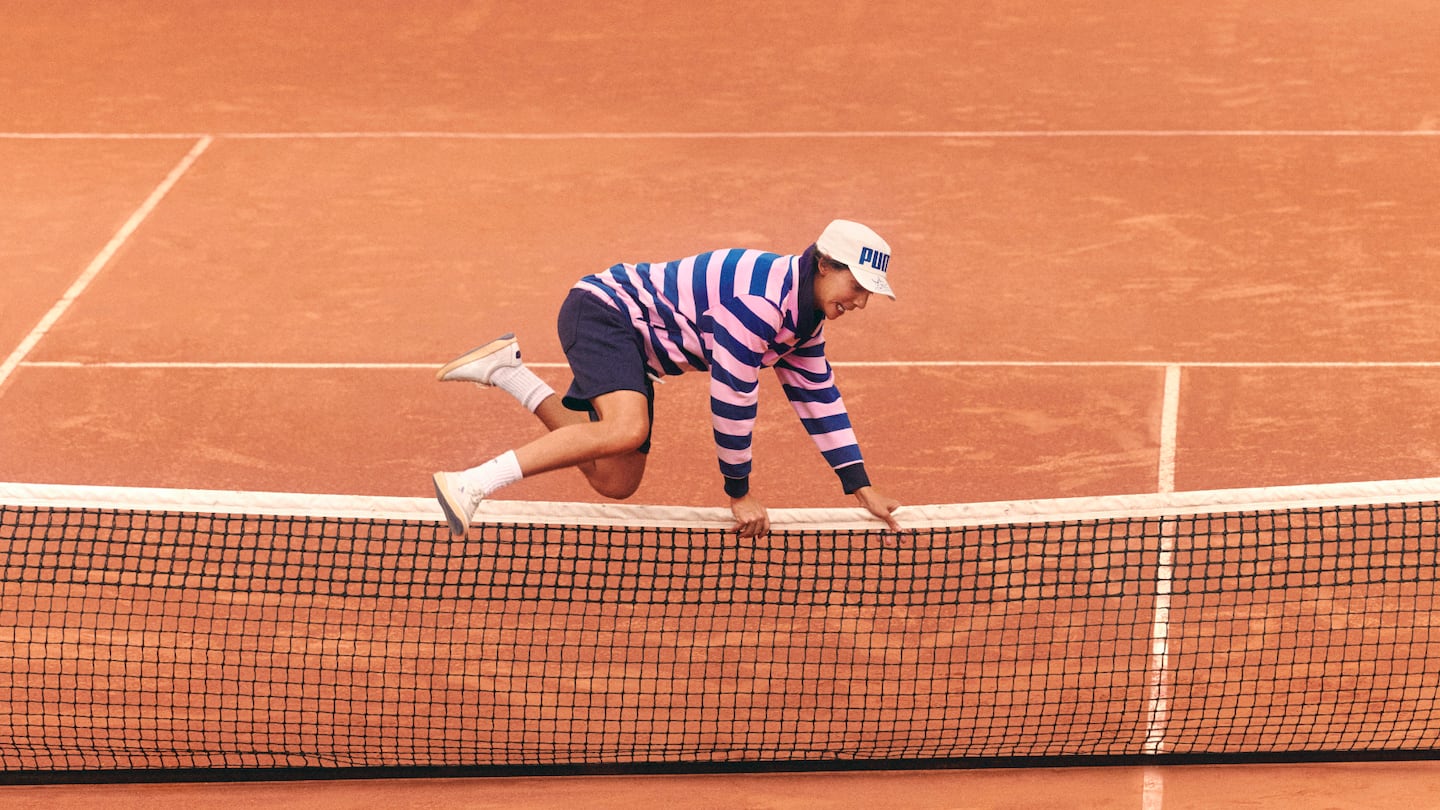
The Business of Fashion
Agenda-setting intelligence, analysis and advice for the global fashion community.

Agenda-setting intelligence, analysis and advice for the global fashion community.

Brendon Babenzien — co-founder of Noah, creative director of J.Crew menswear and all-around streetwear aficionado at large — never heard the term “gorpcore” until recently.
“What core?” He said, when asked about the moniker given to the technical outerwear category for which brands like Arc’teryx and Patagonia are known. “I’ve made a conscious effort to keep my life completely separate from the fashion world,” Babenzien added.
Consciously or not, Babenzien is in fact familiar with gorpcore’s biggest markers — or at least familiar enough to eschew the trend for his latest project, a collaboration between Noah and German sportswear giant Puma.
Pieces in this collection will be a deliberate “departure from the ultra-technical clothing of today,” Puma and Noah said in a joint press release shared with BoF ahead of the tie-up’s announcement on Monday. Instead, the collaboration’s key products include a rugby shirt, a retro Puma tennis sneaker and a velour vest top.
ADVERTISEMENT
The considered wording in this statement points to a wider retreat from the gorpcore category, which emerged in the mid-2010s as pieces like fleece vests and nylon windbreakers began to infiltrate the streetwear scene. But half a decade later, menswear designers say the hype may be already over.
“Hype around technical clothing and sneakers has got to a place where it’s too heavy,” Babenzein said.
Others, meanwhile, call attention to the advent of “quiet luxury,” a new trend of understated formal dressing exemplified by cashmere knitwear, structured jackets and classic button-downs.
“The term gorpcore can be extremely limiting for outdoors brands who have a lot more to offer like soft tailoring or knitwear,” said Patrick Stangbye, creative director of fashion-forward hiking brand Roa, which is owned by Italian fashion group Slam Jam. “There’s something very aspirational about investing in clothing made out of highly technical fabrics and consumers will buy into this with or without the gorpcore trend.”
Accordingly, for brands like Noah and others that thrive at the intersection of fashion and performance wear, it may be time to move on from the shell jackets and cargo pants. Consumers are increasingly looking to their favourite performance-wear brands for more elevated styles that benefit from the same technical fabrics, such as soft tailoring and overcoats.
Babenzien’s collection for Puma, the first of a multi-season collaboration, will lean into his signature preppy look, with styles including a pink and blue striped rugby shirt and his take on the Puma Star, an updated version of a tennis shoe the brand released for Wimbledon in 1970. Emphasising the light-hearted nature of the collection — as opposed to the typical serious tenor of technical apparel — photos promoting the tie-up feature a pitch invader charging across a tennis court to the anger of the two players, security guards in pursuit and the spectators, who are all in the nude.

“Back before all clothing got super technical, when you used to play sport you’d just put on whatever you want and get on with it,” said Babenzien. “I just wanted to create a collection that is fun and easy for regular people to wear.”
Gorpcore entered the popular lexicon of fashion in 2017, coined by New York Magazine writer Jason Chen noting the sudden appearance of hiking and camping apparel on celebrities like A$AP Rocky and Drake. Gorp, in fact, stands for “good ol’ raisins and peanuts,” a popular snack among hikers. Chen noted that this will likely be the successor to normcore, another influential trend in the fashion zeitgeist of the 2010s, characterised by plain articles of clothing of white T-shirts and tube socks.
ADVERTISEMENT
Soon, gorpcore became ubiquitous. Trail and hiking footwear from brands like Salomon or Nike’s ACG line became the hottest sneakers on StockX. Adidas’ Terrex, a dedicated line of technical footwear and apparel for activities like hiking, now generates nearly €500 million ($543.5 million) in annual sales, per CEO Bjørn Gulden. Arc’teryx — once a niche climbing strap manufacturer — became an unlikely coveted collaborator to brands such as Jil Sander and Japanese luxury retailer Beams.
For now, the trend is still driving sales and dividends. Amer Sports, the owner of Salomon and Arc’teryx, has plans to reach €5 billion in total revenue, up from €3.4 billion in 2022.
Tastemakers, nonetheless, are noting the over-saturation and mass exposure of gorpcore staples.
In May, when London-based designer Kiko Kostadinov announced the expansion of his long-running collaboration with Asics with a new apparel line, he told BoF he intentionally designed each item without the multiple panels, pockets and zips that consumers have come to expect from gorpcore-heavy tie-ups with sports brands.
“It’s very important to me that we’re not just adding something to the current trend of very male-focused technical wear, you know, guys going around saying: ‘Hey, I have more Arc’teryx stuff than you,’” he said.
Meanwhile, genuine sportswear shoppers are being turned off by gorpcore precisely because of the way in which it has been co-opted by mainstream fashion, turning the practical and accessible nature of outdoor clothing and activities into a competitive, male-dominated and clout-chasing fad.
“The thought of someone seeing me wear the Salomon XT-6s [trail sneakers] and knowing how much money they cost makes me cringe a bit,” said one user in a gorpcore forum on Reddit. “I just hate the idea of people knowing I’m wearing a hyped-up expensive shoe.”
Experts agree that while gorpcore as a fashion trend will likely recede, demand for high-end technical wear is here to stay. Some brands have even merged components of gorp to accommodate the quiet luxury craze.
ADVERTISEMENT
Arc’teryx CEO Stuart Haselden said in April the Canadian outerwear giant is investing in its sub-label called Veilance, in light of growing sales among consumers looking for everyday clothing made from technical fabrics without the typical hallmarks of gorpcore clothing. Veilance is focused on fashion-forward, minimal pieces, including down jackets, wool blazers and trousers, and accessories like bucket hats and backpacks.
Japanese technical outerwear label Goldwin, meanwhile, has found success in introducing minimalistic and loose suiting made from ultra-lightweight wool and bamboo fibre.
Like any trend, gorpcore will inevitably fade from fashion’s public consciousness, today or months from now. Luckily, the solution is simple: To adapt, brands will have to continue making high quality and durable clothing.
“True technical clothing will always have a place in the culture as an aspirational product, especially for consumers in cities who want to show people what they’re about,” Babenzien said.
The Japanese sportswear giant has created a new unisex clothing line called Novalis alongside long-time collaborator Kiko Kostadinov. The sub-brand will be stocked at retailers like Dover Street Market.
Amer Sports plans to scale its three largest companies, including tennis racket maker Wilson, into €1 billion sportswear megabrands by cutting back on wholesale and leaning into their fashion appeal, without altering their core product offerings.
Brands, retailers and investors are betting on trail running, the fast-growing endurance sport, to become activewear’s next big category.

Daniel-Yaw Miller is Senior Editorial Associate at The Business of Fashion. He is based in London and covers menswear, streetwear and sport.
Designer brands including Gucci and Anya Hindmarch have been left millions of pounds out of pocket and some customers will not get refunds after the online fashion site collapsed owing more than £210m last month.
Antitrust enforcers said Tapestry’s acquisition of Capri would raise prices on handbags and accessories in the affordable luxury sector, harming consumers.
As a push to maximise sales of its popular Samba model starts to weigh on its desirability, the German sportswear giant is betting on other retro sneaker styles to tap surging demand for the 1980s ‘Terrace’ look. But fashion cycles come and go, cautions Andrea Felsted.
The rental platform saw its stock soar last week after predicting it would hit a key profitability metric this year. A new marketing push and more robust inventory are the key to unlocking elusive growth, CEO Jenn Hyman tells BoF.